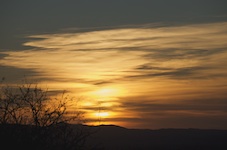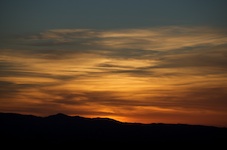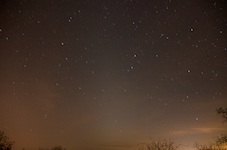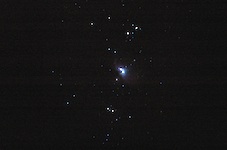7 March 2008 |
I had originally planned to spend two nights at Oracle Observatory with three telescopes: ETX-90RA, ETX-125, and the PST (Personal Solar Telescope). But the weather forecasts for Saturday, 8 March, were not good so I decided to just take the ETX-90RA and the PST and stay for one night. I went up to Oracle early on Friday, 7 March, so that I could get set up and do some solar observing with the PST. I arrived at 1245 MST (love that 20-minute drive vs the 8.5 hours it used to take) with clear skies and a slight breeze with the temperature at 63°F. I completed setting up at 1400 MST. Here's how the setup looked this visit. (click the image to see a larger version; click "Index" to return to this page) I then walked around the area to see how the various plants were coming along as Spring approached. Here are some shots of some of the more interesting ones. (click an image to see a larger version; click "Index" to return to this page) Beginning at 1600 MST I did some solar observing with the PST piggybacked on the ETX-90RA. I also had a "white light" solar filter on the ETX. No sunspots were visible in either white light (ETX) or Hydrogen-Alpha light (PST). In the PST there were three nice prominences visible. I then did some testing with the OPT Camera Adapter to attach my Nikon D70 DSLR to the PST. I tried "prime focus", "eyepiece projection" using a 12mm eyepiece, a 2X Barlow Lens, in various combinations but could not reach a focus. Apparently the PST does not have enough focus travel to allow this to work with my D70. Sunset was at 1824 MST. The temperature had dropped to 51°F and there were some clouds in the west. This made for a pretty sunset. (click image for larger view) By 1925 MST the temperature was down to 43°F. I did some more testing with the Meade mySKY. GPS alignment was successful. I pointed the mySKY at the star "Sirius" and it correctly identified it. I pointed it at Saturn and again it correctly ID-ed it. However, after that all objects that I asked it to "Goto" were at least 5 degrees off. I even asked it to "Goto" Saturn but it was about 10° off! As I wondered during my visit to Oracle Observatory last month, perhaps the mySKY doesn't like temperatures below 50°F. Stay tuned... By 1950 the "Zodiacal Light" was clearly visible in the west. I took several photos over the next 30 minutes in an attempt to best capture this elusive "dust in the plane of the Solar System". You can see it as the thin vertical pale shaft of light in the center of the image below. On the left and right you will see some clouds in our atmosphere that were captured during the 2 minute exposure with the D70 set at ISO 1600. You may find it easier to see the Zodiacal Light in the image if you use "averted vision" (look away to the left or right of the image rather than looking at the center). (click for a larger view) At 2030 MST, with the temperature down to 38°F, I decided to do some astrophotography through the ETX-90RA. First up was M42, the Great Nebula in Orion. I attached a wide-field adapter at prime focus and then added the OPT prime focus camera adapter to that. I then attached the Stiletto Focuser to focus the image. It had been awhile since I had first tried the Stiletto and then I had only tried it on the LXD75-8"SC (yes, the one that was stolen). I was pleased to discover that it worked fine on the ETX-90. I then swapped the Stiletto for the D70 DSLR. The image appeared in focus in the viewfinder so I started taking some photos. The best shots were 30 second exposures at ISO 1600. Longer exposures were trailed as I was just letting the ETX Right Ascension motor do the tracking with the telescope on a Equatorial Mount and only roughly polar aligned. After I completed a series of photographs of M42 I then moved the telescope to M45, the Pleiades. I used the same set up for a series of exposures with 30 seconds being the best. At this short duration there is no nebulosity visible however. But the familiar star pattern is clearly visible. Here are the two best photos, M42 on the left and M45 on the right. Some Raw image adjustments were made in Apple Aperture 2. (click the images for a larger view) By 2200 MST the temperature had climbed up to 41°F (indicative of the clouds to come). I did some viewing of Saturn with a 9.7mm eyepiece (129X). The Rings were visible, but had very little tilt so details were hard to see. I was able to make out the Rings in-front of the planet. I then decided to pack up some items and retire to the "Astronomer's Quarters" (my tent). When I woke up at 0630 MST on Saturday the skies were totally overcast with the temperature 45°F. I finished packing up and left Oracle Observatory at 0800 MST. Until next time... Go back to the main Oracle Observatory page. |









